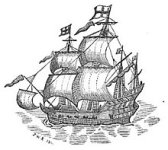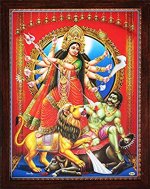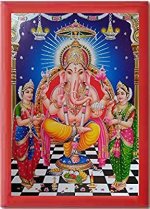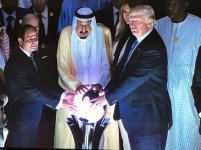Formation of the Masonic East India Company of pirates:
On 22 September 1599, a group of merchants met and stated their intention "to venture in the pretended voyage to the East Indies (the which it may please the Lord to prosper), and the sums that they will adventure", committing £30,133.[19][20] Two days later, "the Adventurers" reconvened and resolved to apply to the Queen for support of the project.[20] Although their first attempt had not been completely successful, they nonetheless sought the Queen's unofficial approval to continue. They bought ships for their venture and increased their capital to £68,373.
The Adventurers convened again a year later, on 31 December, and this time they succeeded; the Queen granted a Royal Charter to "George, Earl of Cumberland, and 215 Knights, Aldermen, and Burgesses" under the name, Governor and Company of Merchants of London trading with the East Indies.[13][21] For a period of fifteen years, the charter awarded the newly formed company a monopoly on English trade with all countries east of the Cape of Good Hope and west of the Straits of Magellan.[21] Any traders in breach of the charter without a licence from the company were liable to forfeiture of their ships and cargo (half of which went to the Crown and the other half to the company), as well as imprisonment at the "royal pleasure".[22]
The governance of the company was in the hands of one governor and 24 directors or "committees", who made up the Court of Directors. They, in turn, reported to the Court of Proprietors, which appointed them. Ten committees reported to the Court of Directors. According to tradition, business was initially transacted at the Nags Head Inn, opposite St Botolph's church in Bishopsgate, before moving to India House in Leadenhall Street.[23]
Sir James Lancaster commanded the first East India Company voyage in 1601 aboard the Red Dragon.[24] After capturing a rich 1,200 ton Portuguese Carrack in the Malacca Straits the trade from the booty enabled the voyagers to set up two "factories" – one at Bantam on Java and another in the Moluccas (Spice Islands) before leaving.[25] They returned to England in 1603 to learn of Elizabeth's death but Lancaster was Knighted by the new King James I.[26] By this time the war with Spain had ended but the Company had successfully and profitably breached the Spanish and Portuguese monopoly, with new horizons opened for the English.[14]
In March 1604, Sir Henry Middleton commanded the second voyage.General William Keeling, a captain during the second voyage, led the third voyage aboard the Red Dragon from 1607 to 1610 along with the Hector under Captain William Hawkins and the Consent under Captain David Middleton.[27]
Early in 1608 Alexander Sharpeigh was appointed captain of the company's Ascension, and general or commander of the fourth voyage. Thereafter two ships, Ascension and Union (captained by Richard Rowles) sailed from Woolwich on 14 March 1607–1608.[27] This expedition would be lost.[28]
Expansion
Edit
The company, which benefited from the imperial patronage, soon expanded its commercial trading operations. It eclipsed the Portuguese Estado da Índia, which had established bases in Goa, Chittagong, and Bombay, which Portugal later ceded to England as part of the dowry of Catherine of Braganza on her marriage to King Charles II. The East India Company also launched a joint attack with the Dutch United East India Company (VOC) on Portuguese and Spanish ships off the coast of China, which helped secure EIC ports in China.[30] The company established trading posts in Surat (1619), Madras (1639), Bombay (1668), and Calcutta (1690). By 1647, the company had 23 factories, each under the command of a factor or master merchant and governor, and 90 employees[clarification needed] in India. The major factories became the walled forts of Fort William in Bengal, Fort St George in Madras, and Bombay Castle.
In 1634, the Mughal emperor extended his hospitality to the English traders to the region of Bengal, and in 1717 completely waived customs duties for their trade. The company's mainstay businesses were by then cotton, silk, indigo dye, saltpetre, and tea. The Dutch were aggressive competitors and had meanwhile expanded their monopoly of the spice trade in the Straits of Malacca by ousting the Portuguese in 1640–1641. With reduced Portuguese and Spanish influence in the region, the EIC and VOC entered a period of intense competition, resulting in the Anglo-Dutch Wars of the 17th and 18th centuries.
Within the first two decades of the 17th century, the Dutch East India Company or Vereenigde Oostindische Compagnie, (VOC) was the wealthiest commercial operation in the world with 50,000 employees worldwide and a private fleet of 200 ships. It specialised in the spice trade and gave its shareholders 40% annual dividend.[31]
The British East India Company was fiercely competitive with the Dutch and French throughout the 17th and 18th centuries over spices from the Spice Islands. Spices, at the time, could only be found on these islands, such as pepper, ginger, nutmeg, cloves and cinnamon could bring profits as high as 400 percent from one voyage.[32]
The tension was so high between the Dutch and the British East Indies Trading Companies that it escalated into at least four Anglo-Dutch Wars between them:[32] 1652–1654, 1665–1667, 1672–1674 and 1780–1784.
The Dutch Company maintained that profit must support the cost of war which came from trade which produced profit.[33]
Competition arose in 1635 when Charles I granted a trading licence to Sir William Courteen, which permitted the rival Courteen association to trade with the east at any location in which the EIC had no presence.[34]
In an act aimed at strengthening the power of the EIC, King Charles II granted the EIC (in a series of five acts around 1670) the rights to autonomous territorial acquisitions, to mint money, to command fortresses and troops and form alliances, to make war and peace, and to exercise both civil and criminal jurisdiction over the acquired areas.[35]
In 1689 a Mughal fleet commanded by Sidi Yaqub attacked Bombay. After a year of resistance the EIC surrendered in 1690, and the company sent envoys to Aurangzeb's camp to plead for a pardon. The company's envoys had to prostrate themselves before the emperor, pay a large indemnity, and promise better behaviour in the future. The emperor withdrew his troops, and the company subsequently re-established itself in Bombay and set up a new base in Calcutta.[36]

----
We will inshaAllah next study the relationship between Company Bahadur - Guru Tegh Bahadur - the rabble rousings, riots, and mutinies leading up to Aurangzeb's erratic acquisitions - the 1670 british royal charter to the EIC - the birth of Bahadur's son Guru Gobind Singh the tenth and final sikh Guru born 1666 when his father was visiting between Assam and Bengal (where lies Sylhet - the land which Allah

liberated from the pagan oppression of Gour (guru) Gobinda /Govinda through Shah Jalal ad-Deen around 1303) -
Singh=Shingho=Lion=Horn - the Throne of the Queen of England - seven heads and ten horns - vaisakhi - pohela boishakh - Henry Every -
Ganj-i-Sawai
Bear Burhanuddin's cow sacrifice in mind.


Search the hyphenated terms yourselves if you have time.


 liberated from the pagan oppression of Gour (guru) Gobinda /Govinda through Shah Jalal ad-Deen around 1303) -
liberated from the pagan oppression of Gour (guru) Gobinda /Govinda through Shah Jalal ad-Deen around 1303) -

